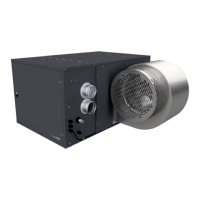page no. 22 of 68
LX Range Users, Installation & Servicing Instructions Doc Ref M110 issue 1.0 Dec 2020.
causing an electrical thermal trip condition. (e.g. by
adjustment of duct outlet nozzles and balancing of the
duct system).
Using a clamp meter around the fan power cable and with
all side panels closed, check the running current of the
centrifugal fan once the heater is running and compared
with the table shown in section 2.6.9.
Adjust the balancing dampers within the airflow ductwork
system to achieve the current suitable for that specific
model.
WARNING: DO NOT EXCEED THE STATED
MAXIMUM. Exceeding the MAX running
current will cause the fan’s thermal overload
to trip!
IMPORTANT. Furthermore, a straight section
of duct with the same cross sectional area as
the heater outlet duct spigot, must be fitted
to outlet spigot prior to any restriction³ in
ductwork. (see sketch). This straight section to be a min
of 1m for floor standing heaters and 2m for suspended.
WARNING: Failure to install this plenum box
could cause excess temperatures issues
with the heater and nuisance overheats.
On suspended heaters, the plenum should be connected
to the heater outlet spigot via an airtight flexible coupling
of non-combustible material.
All ducting must be independently supported of the air
heater. Joints and seams of supply ducts and fittings must
be securely fastened and made airtight.
It is recommended that ducting should be connected
to the heater spigots via an airtight flexible coupling of
noncombustible material. Before fitting coupling it must
be ensured that an adequate clearance will be maintained
between the ends of the ducting and the heater spigots.
If required sound attenuators may be fitted in inlet and
outlet ducts to reduce airborne fan noise. Materials used in
outlet sound attenuators must be capable of withstanding
100°C air temperature without any deterioration.
All delivery and return air ducts, including air filters,
jointing and any insulation or lining must be constructed
entirely of materials which will not contribute to a fire,
are of adequate strength and dimensionally stable for the
maximum internal and external temperatures to which
they are to be exposed during commissioning and normal
operation.
Where inter-joist spaces are used as duct routes they
should be suitably lined with a fire-resisting material.
Direct to outside air
Low level (inlet) 5cm²/kw of total rated net heat input
High level (outlet) 5cm²/kw of total rated net heat input.
1.3.10. Air Distribution System
Where units are installed in buildings having a low heat
loss i.e. where single units are required to cover a large
floor area, and in buildings with ceiling heights over 5M,
Calecon thermal economiser units should be fitted to
ensure even heat distribution and minimise stratification.
1.3.10.1. Freeblowing Applications
These are equipped with horizontal louvres to allow for
adjustment of the direction of the heater for maximum
flexibility and comfort.
Various outlet configurations are available as optional
extras to modify the air throw pattern to suit particular
site conditions.
Care should be taken to avoid impeding the air throw with
racking, partitions, plant or machinery etc.
If necessary, suitable barrier rails should be provided to
prevent any combustible material being placed within
900mm of the outlets.
1.3.10.2. Ducted units
These are designed for use with duct work to more
precisely define the point of air delivery, and /or provide
ducted return air or ducted fresh air inlet.
IMPORTANT. Ductwork must comply with
current regulations and be correctly calculated
to comply with the maximum static resistance
available for the specific model installed (refer
to section 2 - duct resistance/air volume tables).
WARNING Ensure that the total aggregate
resistance¹ of the duct system, including any
dampers, grilles or filters² etc, is equivalent
to the static pressure capability of the
selected heater.
If the total static resistance of the duct system is greater
than the stated for that heater, airflow will be restricted
and the heater may trip to overheat. Resistance must
be reduced to avoid nuisance temperature overheat
conditions.
Conversely if the duct system resistance is insufficient,
then the main fan motor may draw excess current and trip
to overload. Additional resistance must be introduced to
stop the fan motor from 'free-wheeling' and eventually
1.3 General Requirements

